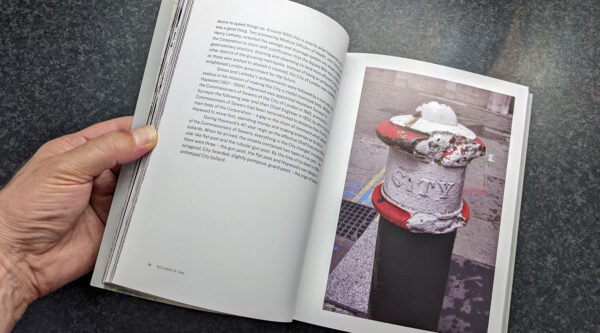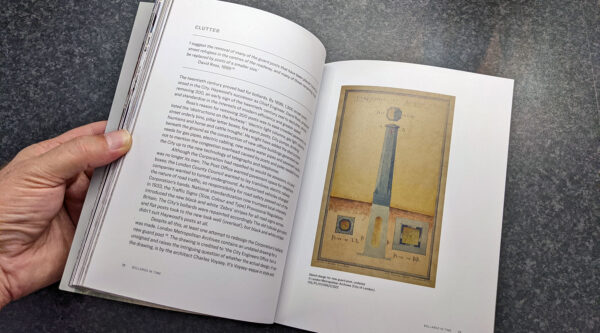Wander around London, and you can always tell when you’re in the City of London, thanks to the ubiquity of the City’s striking red, black and white street bollards. And now a book uncovers the surprising history of these often overlooked elements of street furniture.
Written during the lockdown by local resident and Honorary Research Fellow at the Museum of London, Dr Cathy Ross this isn’t a dry history of metal shapes, but an unexpected love story for an icon of the City of London.
What marks the City of London’s bollards out is their bold decoration and ubiquity. Wander around London and you’d struggle to know which council is in charge, but wander into the City of London, and the bollards exclaim that you are in the City. A forest of black, red and white, and the City’s crest dominate the streets and thanks to their bold designs are far more noticeable than elsewhere with their grey street fencing and bland concrete posts.
There’s a huge variety of street bollards from tall thin poles, which it turns out are often replacements for old parking meters to the big solid fat bollards that are there to protect buildings. London’s very own Fattypuffs and Thinifers if you like.
Dr Ross has spent a lot of time researching the life of a personal favourite of mine, William Haywood, a man who should be a lot better known for his work in the City of London and the early street furniture, and rather less well known for the suggestion that he was the anonymous author of a notorious erotic novel.
There are many links between bollards and street lamps, but while bollards proliferate, if you wander around the City, you’ll realise that there are very few streetlamps mounted on pavements. Most are on the sides of buildings, as the City forced building owners to host street lamps on their behalf. A method of decluttering the streets for pedestrians.
Just as bollards have their hidden depths under the pavement, Dr Ross digs into the history of how the City ended up with such a strong visual identity in its street bollards. Like many things we think have been around forever, it turns out that the bold use of the City of London’s branding is a relatively recent phenomenon and a visual reminder of how planning controls can improve urban appearances.
She weaves through the rise and fall and rise again of the street bollards, from a time when they protected pedestrians from wayward horse-driven carts, to the post-war years when they were seen as unnecessary street clutter to the rise again as protecting buildings became an ever more urgent requirement.
These days, a whole swathe of regulations surround the street bollard when used to protect buildings, and what was once something that was to be removed are popping up like mushrooms all over the place.
As a book, Dr Ross has delivered something rare, a book about something that’s all around us and we hardly pay attention to, and yet has a remarkably fascinating history. It’s a delightful read, and you’ll come away with a far greater appreciation of the hidden effort that goes into shaping our urban landscape. Any London obsessive will love it.
The book, Bollardology by Cathy Ross is published by QuickFry Books, with 170 photos and illustrations, and is available from Amazon, Foyles, Waterstones, and the Guildhall Art Gallery.
Of course, a book called Bollardology is crying out for this famous TV advert.










Watch a movie set in the West End of London, and you can always tell you’re actually seeing footage shot in the City of London, thanks to the ubiquity of the City’s striking red, black and white street bollards!
An odd one is often to be seen elsewhere, how or why, I’m never sure, but it’s fun to imagine.
I spotted one this week in a Rickmansworth garden.
Among other London things which got to Swanage (and its its immediate surrounds),are several iron bollards. Allegedly taken there, along with some other London bits and pieces, as ballast in ships travelling empty back to load more Purbeck stone for London buildings and pavements. The main cluster is around a globe (ex Greenwich). Re-used cannon appear elsewhere, e.g. Plymouth, Portsmouth.